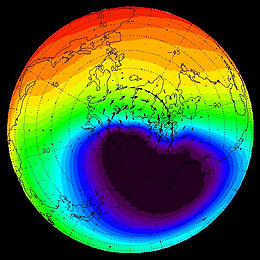
Ionosphere is a part of Earth’s near-space with altitudes from 50-80 km to 400 – 500 km and with relatively high concentration of charged particles.
Ionosphere is divided into regions of higher ion concentration (layers) with a gradual transition between them. There are area D (60-110 km), where ionization almost disappears in the night; F (110 -140 km); F1 (140-220 km) and F2 (220-400 km). The conductivity of the ionosphere is quite large. Already at an altitude of 100 km it is 100- 1000 times greater than the conductivity near the Earth’s surface. Therefore radio waves in the ionosphere undergo absorption, reflection and refraction.
Observations show that the ionosphere. in a state of continuous and complex movement, determined by a complex influence of gravitational forces, electric and magnetic forces, thermal processes. The variable in space and time energy flows entering the ionosphere as well from the bottom – from near-to-surface layers of the atmosphere, as from the top – from the magnetosphere and solar power. The properties of the ionosphere regularly are investigated on large network of stations around the globe using observations of ionospheric reflection from different layers of different radio frequencies. The distribution of electron density in the ionosphere is defined also using rockets and satellites.
In the department are investigated wave processes in the ionosphere based on satellite and surface measurements. The relevance of these studies is due to insufficient study of the problem of the origin of wave disturbances in the ionosphere generated powerful sources of both in the lower atmosphere (storms, weather fronts, earthquakes) and in the magnetosphere and the solar wind (charged particles rash, Joule heating, and other energy emission processes). Research carried out on the basis of theoretical methods of hydrodynamics and magnetoelectrodynamics using numerical methods to compare theoretical models to experimental data.
AGW in the ionosphere. There are developed the methods for determining the spectral and power characteristics of acoustic gravity waves (AGW) on satellite measurements. Determined global patterns of spatial distribution and prevailing directions of AGW propagation on ionospheric heights. A decisive influence of winds on the formation of the wave field of high-thermosphere was detected. It is shown that uniform horizontal flows are natural low-pass filters and amplifiers of acoustic gravity waves. Taking into account this effect let reconcile the results of satellite measurements and ground AGW observations in the polar thermosphere. Within the framework of a simple model it was shown that in the vortex motion of environment occurs AGW with frequencies close to the Brunt–Väisälä frequency. The results are given in comparison with data of satellite measurements over the polar caps AGW. According to the equatorial satellite Atmospheric Explorer-E measurements the basic properties of acoustic gravity waves generated by the movement of the solar terminator at ionospheric heights was investigated. It is shown that the main wave mode moves synchronously with the terminator.
Influence of infrasound on the state of the ionosphere. There was executed a land-space experiment with an active influence on the ionosphere by ground acoustic parametric oscillator (with participation of LC ISR). Using the experimental data and analysis of complex land-space experiments to study the effects of acoustic disturbance of ionosphere was built a new model of non-linear parametric infrasound signal generation and its propagation from the surface of the Earth to the ionosphere.
